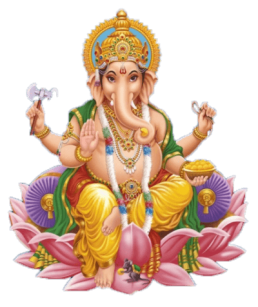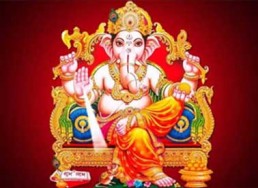Shuklambaradharam
प्रसन्नवदनं ध्यायेत् सर्वविघ्नोपशान्तये ॥
prasannavadanaṃ dhyāyet sarvavighnopaśāntaye

Description
Excerpt from the book ‘Prayer Guide’ by Swami Dayananda Saraswati
This is a very popular verse of prayer to overcome vighnas, obstacles.
There are obstacles possible in your effort to achieve any desired end. To avoid the obstacles, vighnas, you offer a prayer in the beginning requesting that all obstacles be removed. This is a prayer to Lord Ganesa, the one who removes all obstacles.
The word dhyayet should be understood dhyayami, I meditate, because the meaning would be, “May one meditate upon.” You are asking yourself to do dhyana, to visualise, think of, and pray. To whom should you pray and why?
Visnum, the one who is sarva-vyapi, all pervasive. This aspect of all pervasiveness indicates that there is no place where he is not. All that is here is isvara. If you say he is inside, then the Lord is limited. If you say he is outside, then again, the Lord is limited. However, if you say he is inside and outside, you mean that he is limitless. Visnum dhyayami, I salute, I pray to, I meditate upon Visnu, who is all-pervasive.
For the purpose of meditation, we give the Lord a form. Sasivarnam, he is of the colour of the moon, the autumnal moon. He has four hands, caturbhujam; each hand indicating one type of blessing. Suklambaradhara is the one who wears white clothes. White stands for purity, suddha-sattva. He is the who is all sattva, meaning all-knowledge. Prasannavadana is one who has a cheerful face. He is the one whose nature is fullness, ananda-svarupa.
You will find seeming contradictions in all such descriptions. He is all-pervasive but wears white clothes! He is all-pervasive but one who has four hands! If you look beyond this, you can understand the beauty of it; one is the truth, svarupa, and the other is the form for your visualisation, upasana. You need a form to offer a flower.
Sarva-vighna-upasantaye, for the removal of all forms of obstacle. This verse is generally chanted to propitiate and obtain the blessing of Lord Ganesa, the remover of all obstacles.
Other Ganesha Shlokams
Agajanana Padmakam
We meditate day and night on the one-tusked one who is the sun for the lotus in the form of the face of Pārvatī, the one with the elephant face and the one who is the giver of all desired ends to his
Gajananam Bhuta
I bow to you, the Lord with the face of an elephant (Gajanana), one who is served by the celestial attendants (Bhoota ganas) and other beings. The one who consumes the extract of Kapitha (wood apple)
Gananamtva Ganapatim
Among the celestial attendants (Ganas), you are the Lord (Ganapathi), We offer sacrificial oblations to you You are the wisest among the scholars. Your wisdom is known to be highest quality and uncomp
Ganapathi Atharvashirsha
The Ganapati Atharvasirsha Upanishad is a Sanskrit text and a minor Upanishad of Hinduism. It is a late Upanishadic text dedicated to Ganesha, the deity representing intellect.
Ganapati Stotram
As the rays from the lotus-face of Gauri (Devi Parvati) is always on her beloved son Gajanana (Who has the face of an Elephant), Similarly, the grace of Sri Ganesha is always on his devotees; Granting
Ganesh Chathurthi
Significance of Ganesh Puja, Vinayaka Chavithi or Chathurthi. See how to prepare for Ganesha Pooja, How to perform the Puja with Video instructions and enjoy Audio devotional songs, uninterrupted and without ads.
Ganesha Gayatri Mantra
We pray to the one-tusked; we meditate on the one having a twisted trunk. May that Ganapati (one-tusked) inspire us (to meditate).
Ganesha Pancharathnam
The composer, Guru Sri Adi Shankaracharya had praised the God Ganesha by presenting these five stanzas as five jewels, hence the name Maha Ganesha Pancharatnam.
Ganesha Stavah
Ganesha Stavah or Ganapati Stavah is a set of 13 verses that describe the glory of Lord Ganesha. Gaṇapati stavaḥ is said to be from Ganesh Purana - upāsanā khaṇḍa adhyāya 13.
Mooshika Vahana
Salutations to Sri Vighna Vinayaka, whose vehicle is the mouse and who has the modaka in his hand, whose large ears are like fans and who wears a long sacred thread, who is short in stature and is th
Sankata Nashana Ganesha Stotram
This stotram is from Narada Purana. Sankata means problems, difficulties and Nashanam means to destroy. So, by chanting this stotram one is praying to Lord Ganesha to remove his difficulties. In Sanskrit, English Translation, Meaning, Significance…
Vakratunda Mahakaya
O god with the twisted trunk, broad-bodied, brilliant as thousand suns, bless me with freedom from obstructions and hindrances in all my works and for all times.
Shuklambaradharam – Ganesha – In Sanskrit with English Transliteration, Translation and Meaning. Commentary for selected Shlokams.


